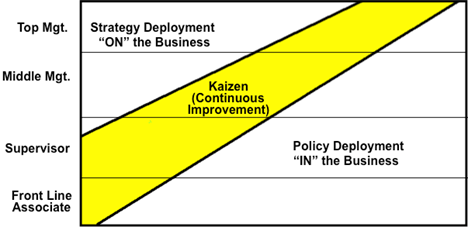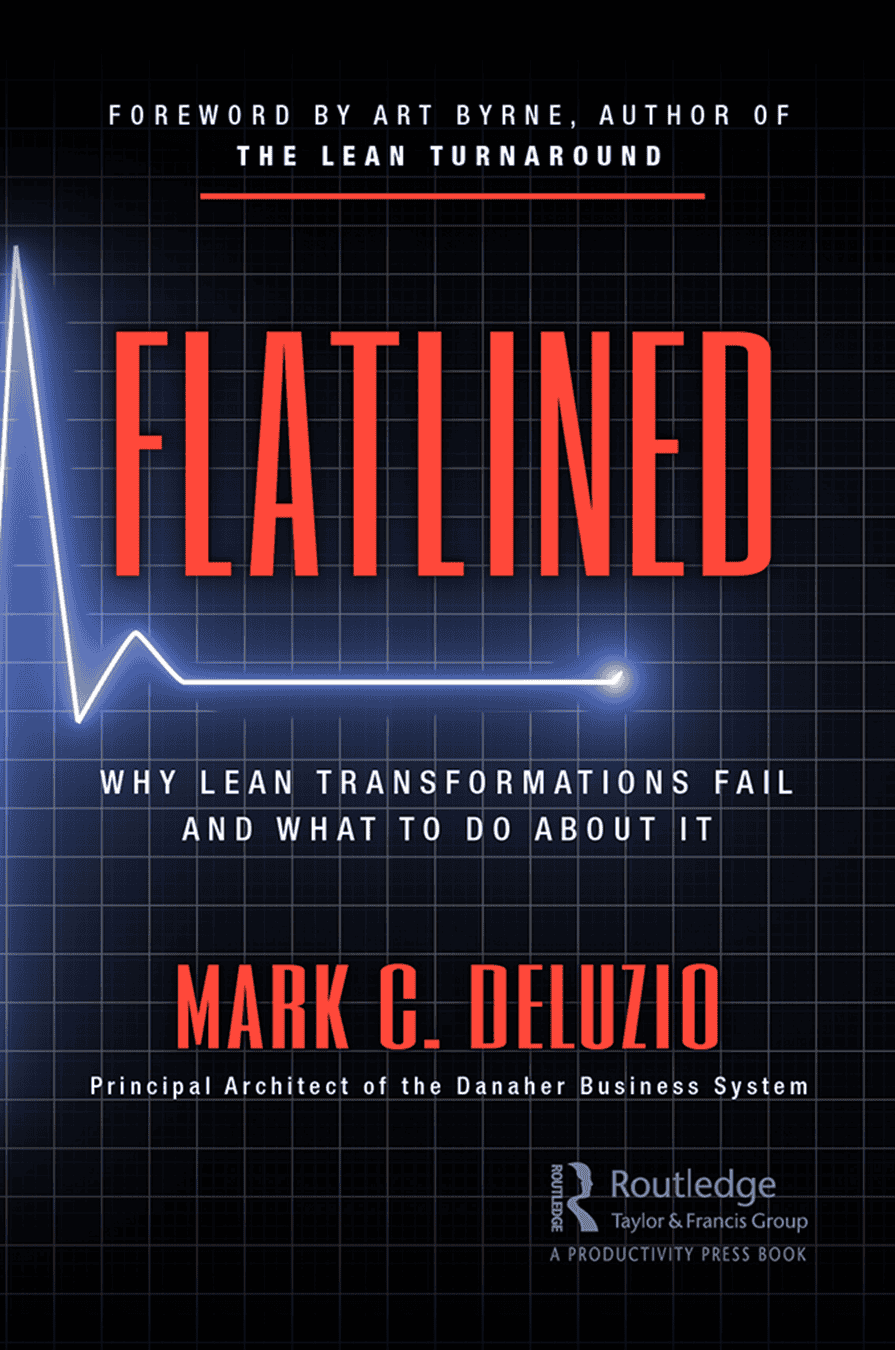Introduction
Mention the phrase “Strategy Deployment” or “Daily Management” and a number of thoughts, concepts and disciplines come to mind. In general, industry has confused the two, which in fact are quite different from one another. The Lean consulting industry added fuel to the fire with service offerings that unknowingly attempted to combine the two approaches, creating chaos and dysfunctional management systems with a lack of focus on what is really important to an organization. Most times, consultants have little or no hands-on experience with these approaches in the real world, adding to the turmoil that they helped create.
Having pioneered the implementation of Strategy Deployment at Danaher in the early 90’s, (note: Danaher is still using this approach today) I can safely say that we made many early mistakes in its implementation and deployment. However, we learned and improved the process using the PDCA cycle (Plan-Do-Check-Act). Most companies today are still using an early vintage of Strategy Deployment and these mistakes are as evident in industry today as they were in the early 90’s at Danaher. One of the biggest faults is the confusion between Strategy Deployment (SD) and Daily Management (DM). This will be the focus of this article.
It is important to understand that I am not advocating the use of one approach vs. another. On the surface, Strategy Deployment and Daily Management look and feel similar, like racquetball and handball. However they are quite different and have different objectives. I believe that SD and DM are both necessary components to a successful Lean transformation. Understanding the difference between the two is paramount to providing clarity and focus as well as delineating your associates’ roles in your Lean transformation.
What is Strategy Deployment?
Strategy Deployment is a proven methodology to implementing your few, key strategic business imperatives. This is done by creating vital business processes that will sustainably perform at Breakthrough levels. We like to say that SD is working “ON” the business, creating a better mousetrap. Since there are a few key strategic initiatives that will be deployed, not everyone in the organization will be involved in the implementation. This is hard for leaders to understand and accept, as the politically correct mentality suggests that everyone needs to be involved otherwise, they will feel “left out.” Typically, senior and middle management are involved in multifunctional teams with less involvement from front line associates, whose primary role is to run the daily operations of the business whether it be in the back office, shop floor, product development, the emergency or operating room, etc. The role of the various levels of management in SD can be seen in the following illustration:

It is important for an organization to determine the proper architecture for their Strategy Deployment. That is, where are you going to seed in top-level SD matrices? At Corporate? At the Platform level? At the Business Unit level? By Geography? By Market? There is no correct answer and as a matter of fact, it could be some combination of all or some of the above. It takes experience to be able to establish the correct architecture and each organization needs to customize its approach as required.
One must also consider the “complexion” or nature of SD. Is it primarily deploying a growth strategy? Is it more focused on operational improvements? Financial improvements? Or is it a hybrid? This is important to understand, and what is “breakthrough” for one organization may not be breakthrough for another. For example, an organization with poor on-time delivery may need an immediate breakthrough in this area before a growth initiative is deployed, while for another organization, their on-time delivery may be at a competitive level and are better positioned to focus on growth initiatives.
Strategy Deployment creates alignment and focus. One of the toughest things to do when setting out on a SD journey is to decide what you are NOT going to do! Too many times I have seen companies with 25 or 30 strategic initiatives…slicing their company a mile wide and a half an inch deep. Ultimately, nothing gets accomplished, the organization is in upheaval and morale is at an all time low. Focus and clarity is the key.
What is Daily Management?
Daily Management is a way to monitor, manage and improve the daily metrics for each function in the organization. It is measured using Key Performance Indicators (KPI’s) and focuses on every function, whether administrative, operational, etc. Typically, Supervisors and Front-Line associates are heavily involved in this process, and use the kaizen method to continually improvement their functional daily management processes. There is no set formula for determining the KPI’s for each and every function, however a good rule of thumb is to focus your KPI metrics around the following categories:
- Safety
- Quality
- Delivery
- Cost
- Growth
Compared with Strategy Deployment, Daily Management touches almost everyone in the organization, while SD touches a select few multifunctional teams. Both methodologies use a similar tracking mechanism (the Bowling Chart) to track their progress, and both use the A3 Countermeasure problem solving process when off track from the plan. Note that DM is all about making continuous improvements in daily management processes rather than breakthrough improvements in a few key strategic areas. Daily Management is known as working “IN” the business.
Robust, high-performing daily management systems are fundamental to the success of Strategy Deployment. If senior leadership is constantly getting dragged down to the daily management level, firefighting due to customer complaints, quality problems, etc., there will be no time for them to work “ON” the business through the Strategy Deployment process. Once again, a severely broken daily management process may in fact become your SD breakthrough before more strategic growth initiatives can be addressed through the SD process.
to work “ON” the business through the Strategy Deployment process. Once again, a severely broken daily management process may in fact become your SD breakthrough before more strategic growth initiatives can be addressed through the SD process.
Summary
Strategy Deployment and Daily Management are both necessary for a successful Lean transformation. Although the tools look similar, they are distinctly different, and need to be managed separately otherwise there will be confusion between strategic breakthrough priorities and daily management improvements. The following chart summarizes the differences between SD and DM:
| Criteria | SD | DM |
|---|---|---|
| Focus | ON the Business | IN the Business |
| People/Teams | Multi-Functional | Functional |
| Initiatives | Strategic | Tactical/Daily Management |
| Scope | Narrow & Deep | Wide/Across Enterprise |
| Metrics | Few – Strategic | Many – KPI’s |
| Improvement | Breakthrough | Incremental |
| Financial | Beyond Budget | Budget |
| Involvement | Select Few | All |
| Impact on Strategy | 80% | 20% |
| Review Cycle | Monthly/Weekly | Daily/Hourly |
| Management Focus | Senior | Middle & Below |
Most companies do not start with Strategy Deployment in their Lean transformation; however, the successful ones ultimately understand that SD and DM are the pathway to becoming a World-Class organization. It is a proven methodology; however, I am sad to say that the misunderstanding of these concepts has resulted in more failures than successes. By understanding the differences, as well as the prescribed techniques relative to each tool, your Speed to Value will be greatly accelerated.

